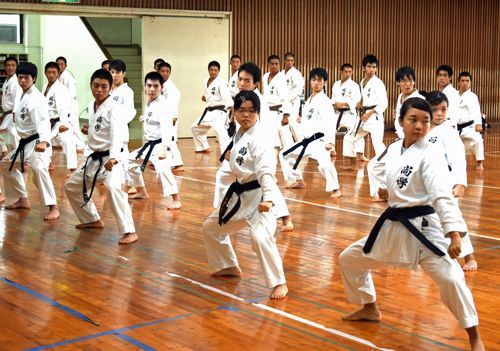Okinawa Shogaku highlights benefits of making karate compulsory

Okinawa Shogaku High School students look serious in an Okinawan karate class on October 5 at the school gym in Naha.
October 21, 2016 Ryukyu Shimpo
It has been a decade since Okinawa Shogaku Junior and Senior High schools and the Federation of Okinawa Karate agreed to make karate a compulsory class at the school. Once a week, 7th to 11th graders (for 12th graders the class is optional) practice under an instructor sent by the federation. In 2015, 491 high school students earned their black belt, which is a pass rate of 44.1 percent. The school says the purpose of making Okinawan karate a compulsory class is for students to learn culture, which will foster a global-mindset. A spokesman for the school says that this has had “profound effects on the students’ ability to focus and on building character.”
Students in karate gi, or uniform, let out a powerful “Hi-ya!” that echoes throughout the school gym. All the students look serious as they practice jabs and kicks with the instructors, who are also the directors of the federation. An 18-year-old with a black belt, Julia Nagaishi says, “The teachers give us detailed instructions, so it’s easy to grasp. I hope to become a soccer player and be successful abroad, but regardless of whether I succeed or not, I’ll still be proud that I can do karate.”
The school and the federation signed the Agreement on Karate Training in August 2007. In class, students learn kata, or a routine comprised of various movements and techniques. In 8th grade, students choose a style of karate they wish to learn from the following four: Uechi-ryu, Goju-ryu, Shorin-ryu, and Matsubayashi-ryu. Those who start from high school primarily learn the Matsubayashi-ryu. There are also predetermined goals for each grade, such as 5-kyu for 7th grade, 3-kyu for 8th grade, and 2-kyu for 9th grade. Those who started in junior high school aim for a black belt, while those who started in high school aim for a brown belt by the time they graduate from high school. Twice a year, the federation holds grading tests. For 7th graders, it is only once a year. In 2015, more than 90 percent from each grade in junior high school achieved their goal, and in high school, it was 85 percent.
Akio Shimabukuro, vice president of the federation and an instructor, has high hopes for the classes. He says, “Students become so mature that it makes you do a double take. And this happens while we’re still teaching the basics. Learning karate, which was developed by early Okinawans, will immensely benefit students in becoming global-minded people.”
High school Vice Principal Hiroaki Yoza emphasizes the positive effects of making Okinawan karate a compulsory class. He says, “We are able to place Okinawan culture at the core as we try to foster global-minded people. Learning karate has changed the attitude students have toward their daily life, it gives them confidence in many different areas, and it has contributed to building character.”
(English translation by T&TC and Chelsea Ashimine)
Previous Article:Onaga responds to riot police officer using discriminatory term for Okinawan protesters
Next Article:5th Worldwide Youth Uchinanchu Festival held to deepen bond for Okinawaʻs future
[Similar Articles]
- Okinawa International School starts offering Shimakutuba classes
- Strengthen your immune system with radio karate along with a Naha Tomari Elementary school teacher
- 90 percent of students in Miyako Island not using local dialect
- OPG publishes book to help elementary and junior high students learn Shimakutuba
- 75-year-old Okinawan woman attains a Karate black belt
 Webcam(Kokusai Street)
Webcam(Kokusai Street)


